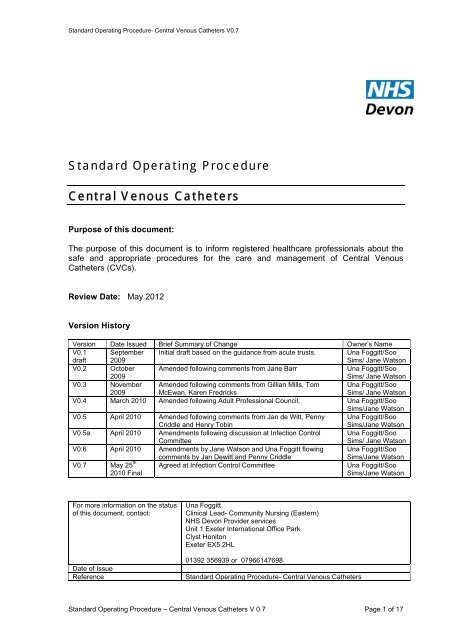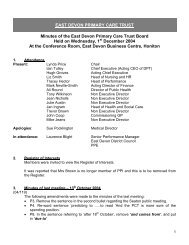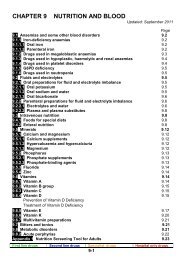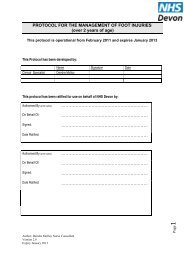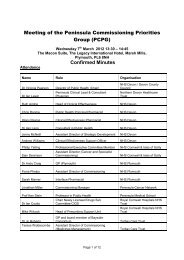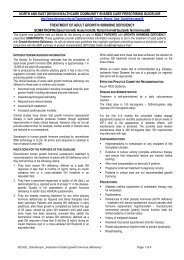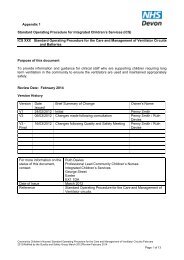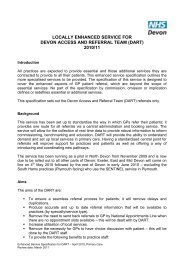Standard Operating Procedure Central Venous ... - NHS Devon
Standard Operating Procedure Central Venous ... - NHS Devon
Standard Operating Procedure Central Venous ... - NHS Devon
You also want an ePaper? Increase the reach of your titles
YUMPU automatically turns print PDFs into web optimized ePapers that Google loves.
<strong>Standard</strong> <strong>Operating</strong> <strong>Procedure</strong>- <strong>Central</strong> <strong>Venous</strong> Catheters V0.7<br />
<strong>Standard</strong> <strong>Operating</strong> <strong>Procedure</strong><br />
<strong>Central</strong> <strong>Venous</strong> Catheters<br />
Purpose of this document:<br />
The purpose of this document is to inform registered healthcare professionals about the<br />
safe and appropriate procedures for the care and management of <strong>Central</strong> <strong>Venous</strong><br />
Catheters (CVCs).<br />
Review Date: May 2012<br />
Version History<br />
Version Date Issued Brief Summary of Change Owner’s Name<br />
V0.1 September Initial draft based on the guidance from acute trusts. Una Foggitt/Soo<br />
draft 2009<br />
Sims/ Jane Watson<br />
V0.2 October Amended following comments from Jane Barr Una Foggitt/Soo<br />
2009<br />
Sims/ Jane Watson<br />
V0.3 November Amended following comments from Gillian Mills, Tom Una Foggitt/Soo<br />
2009 McEwan, Karen Fredricks<br />
Sims/ Jane Watson<br />
V0.4 March 2010 Amended following Adult Professional Council. Una Foggitt/Soo<br />
Sims/Jane Watson<br />
V0.5 April 2010 Amended following comments from Jan de Witt, Penny Una Foggitt/Soo<br />
Criddle and Henry Tobin<br />
Sims/Jane Watson<br />
V0.5a April 2010 Amendments following discussion at Infection Control Una Foggitt/Soo<br />
Committee<br />
Sims/ Jane Watson<br />
V0.6 April 2010 Amendments by Jane Watson and Una Foggitt flowing Una Foggitt/Soo<br />
comments by Jan Dewitt and Penny Criddle<br />
Sims/Jane Watson<br />
V0.7 May 25 th<br />
Agreed at Infection Control Committee Una Foggitt/Soo<br />
2010 Final<br />
Sims/Jane Watson<br />
For more information on the status<br />
of this document, contact:<br />
Una Foggitt<br />
Clinical Lead- Community Nursing (Eastern)<br />
<strong>NHS</strong> <strong>Devon</strong> Provider services<br />
Unit 1 Exeter International Office Park<br />
Clyst Honiton<br />
Exeter EX5 2HL<br />
01392 356939 or 07966147698<br />
Date of Issue<br />
Reference <strong>Standard</strong> <strong>Operating</strong> <strong>Procedure</strong>- <strong>Central</strong> <strong>Venous</strong> Catheters<br />
<strong>Standard</strong> <strong>Operating</strong> <strong>Procedure</strong> – <strong>Central</strong> <strong>Venous</strong> Catheters V 0.7 Page 1 of 17
<strong>Standard</strong> <strong>Operating</strong> <strong>Procedure</strong>- <strong>Central</strong> <strong>Venous</strong> Catheters V0.7<br />
Contents<br />
1. Background<br />
2. Definition of <strong>Central</strong> <strong>Venous</strong> Catheters<br />
3. Types of <strong>Central</strong> <strong>Venous</strong> Lines<br />
4. Principles of <strong>Central</strong> <strong>Venous</strong> Catheter Site Care<br />
5. Dressing for PICC<br />
6. Tunnelled Catheter Dressing<br />
7. Totally Implanted <strong>Venous</strong> Access Device Dressing<br />
8. Maintaining Patency and accessing the CVC<br />
9. Frequency of flushing<br />
10. Blood Aspiration<br />
11. Changing Needle-free Connector<br />
12. Trouble shooting<br />
13. Diagnosis of Catheter-Related Infection<br />
14. Clinical Record Keeping<br />
15. Incidents/Adverse Drug Reactions.<br />
16. Useful Contact Numbers<br />
17. References<br />
This <strong>Standard</strong> <strong>Operating</strong> <strong>Procedure</strong> links to:<br />
<strong>Devon</strong> PCT Consent Policy<br />
<strong>Devon</strong> PCT Provider Services Medicines Policy and accompanying <strong>Standard</strong> <strong>Operating</strong><br />
<strong>Procedure</strong>s<br />
<strong>Devon</strong> PCT Incident Policy<br />
<strong>Devon</strong> PCT Injectable Medicines Policy<br />
<strong>Devon</strong> PCT Waste Management Policy<br />
Medical Devices Policy<br />
Infection Control<br />
Anaphylaxis Policy<br />
<strong>Devon</strong> PCT Clinical Record Keeping<br />
Royal <strong>Devon</strong> and Exeter <strong>NHS</strong> Foundation Trust – Guidelines for the Management of <strong>Central</strong><br />
<strong>Venous</strong> Catheters (2008)<br />
South <strong>Devon</strong> Healthcare <strong>NHS</strong> Foundation Trust Implanted <strong>Central</strong> <strong>Venous</strong> Catheter (protect)<br />
Plymouth Hospitals <strong>NHS</strong> Trust 9 <strong>Central</strong> <strong>Venous</strong> Access Device (CVAD) training and<br />
Resource Pack<br />
Right Patient/ Right Blood<br />
Mental Capacity Act<br />
1. Background<br />
<strong>Standard</strong> <strong>Operating</strong> <strong>Procedure</strong> – <strong>Central</strong> <strong>Venous</strong> Catheters V 0.7 Page 2 of 17
<strong>Standard</strong> <strong>Operating</strong> <strong>Procedure</strong>- <strong>Central</strong> <strong>Venous</strong> Catheters V0.7<br />
A <strong>Standard</strong> <strong>Operating</strong> <strong>Procedure</strong> (SOP) has been developed for the care and management of<br />
<strong>Central</strong> <strong>Venous</strong> Catheters (CVC). It acknowledges the work undertaken by the Acute Trusts<br />
at Exeter, Plymouth and South <strong>Devon</strong>.<br />
This SOP is supported by the Injectable Medicines Policy, which outlines the procedure for the<br />
safe administration of medication via the injectable route and this includes medication e.g.<br />
Heparinised saline (Hepsal)/ and normal saline 0.9% via CVC’s.<br />
The SOP will apply to registered staff employed by <strong>Devon</strong> Provider Services who work within<br />
the community hospital and community setting with adults and children. Staff will have<br />
undertaken specific training to work within this SOP namely: Intravenous administration, CVC<br />
training, Right Patient Right Blood in addition to the mandatory training required by the<br />
employer.<br />
This SOP refers to the care of a CVC after insertion in the acute trust setting and when<br />
the patient is referred back to primary care. It does not cover the removal of CVC in<br />
Primary Care.<br />
This SOP refers to Peripherally Inserted <strong>Central</strong> Catheter (PICC); Skin tunnelled<br />
catheter (Hickman) and Totally implanted venous access device (TIVAD Portacath) and<br />
does NOT refer to short-term non-tunnelled catheters.<br />
In undertaking any procedure relating to <strong>Central</strong> <strong>Venous</strong> Catheters consent must be<br />
obtained in accordance with <strong>NHS</strong> <strong>Devon</strong> Provider Services Consent Policy.<br />
2. Definition of a <strong>Central</strong> <strong>Venous</strong> Catheter<br />
An intravascular catheter placed, within the superior or inferior vena cava or other large<br />
central vein. Ideal tip placement is the distal innominate vein or proximal superior vena cava<br />
(SVC).<br />
3. Types of <strong>Central</strong> <strong>Venous</strong> Lines<br />
3.1. Peripherally Inserted <strong>Central</strong> Catheter (PICC) - is sited in the Basilic or cephalic veins<br />
or brachial complex vein utilising ultrasound.<br />
3.2 Skin tunnelled long term catheter (Hickman) – lies in a subcutaneous tunnel before<br />
entering a central vein usually the subclavian.<br />
3.3 Totally implanted venous access device (TIVAD Portacath). A tunnelled device under<br />
the skin in the internal jugular or subclavian vein.<br />
4. Principles of <strong>Central</strong> <strong>Venous</strong> Catheter Site Care<br />
The main principles listed below apply to all CVCs; specific management issues will be<br />
addressed under each heading.<br />
4.1 A care plan must always be in place when undertaking care of a patient with a CVC.<br />
4.2 Following insertion CVCs must be securely fixed, with sutures or a securing device, to<br />
reduce trauma to the exit site and to prevent movement of the line (exception tunnelled<br />
lines ref section 6), which may allow organisms to migrate into the vein.<br />
<strong>Standard</strong> <strong>Operating</strong> <strong>Procedure</strong> – <strong>Central</strong> <strong>Venous</strong> Catheters V 0.7 Page 3 of 17
<strong>Standard</strong> <strong>Operating</strong> <strong>Procedure</strong>- <strong>Central</strong> <strong>Venous</strong> Catheters V0.7<br />
4.3 Adherence to infection control principles is key in reducing risk of CVC related<br />
infection. Before dressing a CVC hands must be cleansed with an alcohol rub, an<br />
apron worn, and an aseptic technique using sterile gloves and a sterile pack.<br />
4.4 If there is haemoserous fluid (usually 24- 48 hours post insertion) sterile gauze<br />
secured with a sterile transparent dressing should be applied, but changed daily.<br />
4.5 Where possible the use of sterile gauze should be avoided as this prevents the site<br />
being observed. If unavoidable this should be changed every 24 hours and when<br />
visibly soiled.<br />
4.6 The site must be disinfected at every dressing change to reduce microbial colonisation.<br />
2% chlorhexidine gluconate in 70% alcohol is the standard cleansing solution.<br />
4.7 A transparent semi-permeable Intravenous (IV) dressing should be applied when area<br />
is dry, and changed every 7 days or more frequently if dressing is no longer intact or if<br />
moisture collects at site.<br />
4.8 Once Hickman line sutures are removed, it is best practice to leave the site uncovered.<br />
4.9 Scissors should not be used near CVCs because of the risk of damage to the catheter.<br />
4.10 Dressing change or observation must be documented including site condition, dressing<br />
used and action taken if complication has arisen.<br />
5. Dressing for PICC<br />
A securing device (e.g. Stat-lock) is used to secure the catheter in place. Following insertion<br />
there is one puncture site. This should be observed daily (through a transparent dressing)<br />
when an inpatient.<br />
5.1 Frequency of dressing change:<br />
Every seven days<br />
When required if dressing is loose or damp<br />
5.2 Equipment for <strong>Procedure</strong>:<br />
Clean Trolley, Tray and a sterile field<br />
Dressing pack (containing sterile gloves & apron)<br />
2% chlorhexidine gluconate in 70% alcohol (e.g. Chloraprep)<br />
Transparent semi-permeable dressing (e.g. IV 3000)<br />
Securing device e.g.Stat-lock<br />
Skin closures e.g. steristrips<br />
5.3 <strong>Procedure</strong>:<br />
5.3.1 Explain procedure to patient and obtain consent in accordance with the <strong>NHS</strong> <strong>Devon</strong><br />
Consent Policy.<br />
5.3.2 Cleanse hands.<br />
5.3.3 If visibly soiled, wash and dry hands thoroughly.<br />
5.3.4 If visibly clean, rub alcohol hand gel into all surfaces until completely dry.<br />
5.3.5 Open dressing pack.<br />
<strong>Standard</strong> <strong>Operating</strong> <strong>Procedure</strong> – <strong>Central</strong> <strong>Venous</strong> Catheters V 0.7 Page 4 of 17
<strong>Standard</strong> <strong>Operating</strong> <strong>Procedure</strong>- <strong>Central</strong> <strong>Venous</strong> Catheters V0.7<br />
5.3.6 Put on apron.<br />
5.3.7 Cleanse hands.<br />
5.3.8 Remove old transparent dressing in an upwards direction to prevent displacement.<br />
5.3.9 Observe condition of catheter insertion site.<br />
5.3.10 Cleanse hands and prepare equipment<br />
5.3.11 Apply sterile gloves.<br />
5.3.12 Disinfect around line site using 2% chlorhexidine gluconate in 70% alcohol (contact<br />
time 30-60 seconds, allow 30 seconds to air dry) .<br />
5.3.13 Renew skin closures e.g. steristrips.<br />
5.3.14 Replace transparent dressing (e.g..IV 3000).<br />
5.3.15 Change Statlock every 7 days, unless visibly soiled and/or lifting, in which case it<br />
should be changed earlier.<br />
5.3.16 A stockinette e.g. Comfifast may be required.<br />
5.3.17 Dispose of equipment as <strong>NHS</strong> <strong>Devon</strong> Policy for Waste Management. Cleanse hands.<br />
5.3.18 Document procedure and condition of site in relevant documentation.<br />
6. Tunnelled Catheter Dressing<br />
Sutures must be removed by a practitioner who is competent in the care of tunnelled<br />
catheters, especially the exit site suture due to the close proximity to the catheter.<br />
6.1 Following insertion there are two puncture sites ‘entry and exit’ with sutures. The entry<br />
suture can be removed 7-10 days post insertion, once suture is removed leave<br />
exposed.<br />
Exit (around the line) site suture can be removed 14 -21 days or left longer if required<br />
to allow fibrosis of tissues around Dacron cuff to occur.<br />
6.2 The tunnelled catheter should be looped once around the exit site under the dressing<br />
when suture in situ, to avoid any trauma at the insertion site.<br />
6.3 Fibrosis will occur to secure the catheter in place, and the exit site suture can be<br />
removed. The area can now be left exposed, with micro-pore or a pouch used to<br />
secure the catheter.<br />
6.4 Frequency of Dressing Change:<br />
- Every seven days<br />
- When required if dressing is loose or damp<br />
6.5 Equipment for <strong>Procedure</strong>:<br />
- Clean Trolley, tray and a sterile field<br />
<strong>Standard</strong> <strong>Operating</strong> <strong>Procedure</strong> – <strong>Central</strong> <strong>Venous</strong> Catheters V 0.7 Page 5 of 17
<strong>Standard</strong> <strong>Operating</strong> <strong>Procedure</strong>- <strong>Central</strong> <strong>Venous</strong> Catheters V0.7<br />
- Dressing pack (containing sterile gloves and apron)<br />
- 2% chlorhexidine gluconate in 70% alcohol (i.e. Chloraprep) plus one<br />
disinfectant wipe (e.g.PDI wipe)<br />
- Transparent semi-permeable dressing (e.g.IV 3000)<br />
6.6 <strong>Procedure</strong>:<br />
6.6.1 Explain procedure to patient and obtain consent in accordance with the <strong>NHS</strong> <strong>Devon</strong><br />
Consent Policy.<br />
6.6.2 Cleanse hands: if visibly soiled wash, and dry hands thoroughly.<br />
6.6.3 If visibly clean, rub alcohol hand gel into all surfaces until completely dry.<br />
6.6.4 Open dressing pack.<br />
6.6.5 Put on apron.<br />
6.6.6 Cleanse hands.<br />
6.6.7 Carefully remove old dressing and discard.<br />
6.6.8 Observe catheter insertion site for complications.<br />
6.6.9 Cleanse hands and prepare equipment.<br />
6.6.10 Apply sterile gloves.<br />
6.6.11 Using a sterile piece of gauze, hold the line away from the skin, clean the area using<br />
2% chlorhexidine gluconate in 70% alcohol swab stick, ensuring a contact time of 30<br />
60 seconds.<br />
6.6.12 Continuing to hold the line away from the skin use 2% chlorhexidine gluconate in<br />
70% alcohol wipe to thoroughly clean line working from exit site outwards.<br />
6.6.13 Allow area to air dry.<br />
6.6.14 Apply dressing. Once sutures have been removed and the wound is sufficiently<br />
healed it can be left exposed if patient chooses.<br />
6.6.15 Dispose of equipment as per <strong>NHS</strong> <strong>Devon</strong> Policy for Waste Management.<br />
6.6.16 Cleanse hands.<br />
6.6.17 Document procedure and condition of site in relevant documentation.<br />
7. Totally Implanted <strong>Venous</strong> Access Device Dressing<br />
Immediately after insertion sterile gauze will be in place, the site should be inspected and<br />
“port” accessed. A sterile gauze dressing is appropriate for the first 24 hours, once the site is<br />
dry dressed with a sterile transparent semi-permeable dressing. Sutures, if used, can be<br />
removed 7-10 days after insertion; once sutures are removed the area should be left exposed.<br />
7.1 Frequency of dressing change<br />
Apply transparent semi-permeable dressing when the “port” is in use.<br />
<strong>Standard</strong> <strong>Operating</strong> <strong>Procedure</strong> – <strong>Central</strong> <strong>Venous</strong> Catheters V 0.7 Page 6 of 17
<strong>Standard</strong> <strong>Operating</strong> <strong>Procedure</strong>- <strong>Central</strong> <strong>Venous</strong> Catheters V0.7<br />
Change:<br />
� Every seven days (to coincide with change of Gripper needle)<br />
� When required if dressing is loose or damp<br />
Follow procedure section 6.<br />
8. Maintaining Patency and Accessing the CVC<br />
General Information<br />
• Adherence to infection control principles is key in reducing risk of CVC related infection.<br />
Prior to any manipulation of the line, hands should be washed or an alcohol rub used.<br />
Attention to an “aseptic non-touch technique” is required during procedures where the<br />
system remains closed. Key parts (end of catheter hub, seal of needlefree connector,<br />
luer of syringe or infusion set) must not be handled.<br />
• An aseptic technique using sterile gloves is required whenever the connector is<br />
removed and the catheter is “open”.<br />
• Always observe the insertion site prior to accessing the devices; if any signs of<br />
infection, thrombosis or misplacement are present do not use. See Section 12 on<br />
complications of CVCs for advice on further management.<br />
• A sterile field should be placed under the line during flushing to provide a sterile fluid<br />
impermeable barrier, which will reduce the risk of micro-organisms being introduced.<br />
• Connections must be disinfected with 2% chlorhexidine gluconate in 70% alcohol<br />
(contact time 30-60 seconds, allow 30 seconds to air dry) before breaking connection,<br />
prior to and after accessing the catheter.<br />
• Except for emergency access haemodialysis CVCs must not be used for any other<br />
purpose.<br />
• Manipulation of the catheter should be kept to a minimum by good co-ordination of drug<br />
regimen, blood taking and line connection changing where possible.<br />
• Each lumen should be treated as a separate catheter with regard to maintaining<br />
patency and when infusing drugs. If the need arises to infuse two or more drugs via one<br />
lumen refer to Injectable Medicines Policy or contact Lead Pharmacist or acute Trust<br />
Pharmacy for advice on compatibility.<br />
• Syringes smaller than 10ml exert too great a pressure on the central line and should not<br />
be used. (Neonatal and paediatric areas should refer to local guidelines)<br />
• Administer final flush using the push pause method (pushing 1ml at a time). This<br />
causes turbulence within the catheter lumen, removing any debris from the internal<br />
catheter wall. If using an IV connector which does not provide positive pressure, apply<br />
positive pressure by maintaining pressure on the syringe plunger whilst administering<br />
the last 0.5ml and simultaneously clamping the line. If using a positive pressure<br />
connector, administer final flush, remove syringe then clamp the line.<br />
9. Frequency of Flushing<br />
All CVCs.<br />
<strong>Standard</strong> <strong>Operating</strong> <strong>Procedure</strong> – <strong>Central</strong> <strong>Venous</strong> Catheters V 0.7 Page 7 of 17
<strong>Standard</strong> <strong>Operating</strong> <strong>Procedure</strong>- <strong>Central</strong> <strong>Venous</strong> Catheters V0.7<br />
• When catheter is in use, it must be flushed before and after blood sampling, drug<br />
administration, or when discontinuing an infusion.<br />
• If blood is noted in the catheter, flushing is required.<br />
• If connector becomes loose, change the connector (see section 11) and then flush.<br />
9.1 Flushing Solution:<br />
• Solution used for the flushing of CVC must be prescribed in accordance with the<br />
Medicines and Injectable Medicines Policy on the Provider Services Prescription and<br />
Medication Administration Record.<br />
• The volume of solution required will vary (e.g. lower volumes will be used in the<br />
neonatal unit). However the volume should be equal to at least twice the volume<br />
capacity of the catheter and add-on devices.<br />
9.2 Frequency of flushing:<br />
For PICC or Tunnelled CVC<br />
Daily access - 0.9% sodium chloride<br />
Weekly access – Heparinised saline (10 units/ml)<br />
Totally implanted venous access device<br />
Daily access - 0.9% sodium chloride (10mls)<br />
Monthly access – Heparinised saline, 5-6ml (100 units/ml)<br />
9.3 <strong>Procedure</strong> for Access via a Needlefree Connector:<br />
9.3.1 Explain procedure to patient and obtain consent in accordance with the <strong>NHS</strong> <strong>Devon</strong><br />
Consent Policy.<br />
9.3.2 Cleanse hands:<br />
if visibly soiled, wash and dry hands thoroughly;<br />
if visibly clean, rub alcohol hand gel into all surfaces until completely dry.<br />
9.3.3 Open dressing pack.<br />
9.3.4 Put on apron.<br />
9.3.5 Prepare equipment required on a sterile field or clean tray.<br />
9.3.6 Apply clean non-sterile gloves. Draw up required flushing solution/drugs to be<br />
administered, checking against prescription chart. Ensure key parts: tip of<br />
syringe, hub of needle and seal of IV Connector, are not touched during procedure<br />
(“aseptic non touch technique”).<br />
9.3.7 Dispose of non sterile gloves.<br />
9.3.8 Prepare patient and perform necessary checks.<br />
9.3.9 Locate the catheter.<br />
9.3.10 Cleanse hands.<br />
9.3.11 Apply clean non-sterile gloves.<br />
<strong>Standard</strong> <strong>Operating</strong> <strong>Procedure</strong> – <strong>Central</strong> <strong>Venous</strong> Catheters V 0.7 Page 8 of 17
<strong>Standard</strong> <strong>Operating</strong> <strong>Procedure</strong>- <strong>Central</strong> <strong>Venous</strong> Catheters V0.7<br />
9.3.12 Position sterile field so that the connector (once disinfected) can rest in the centre.<br />
9.3.13 Disinfect IV connector thoroughly with a 2% chlorhexidine gluconate in 70% alcohol<br />
impregnated swab (contact time 30-60 seconds, allow 30 seconds to air dry).<br />
9.3.14 Remove needle from syringe and discard into sharps bin.<br />
9.3.15 Hold catheter to stabilise.<br />
9.3.16 Firmly push and twist syringe into IV connector, ensure syringe remains securely<br />
attached.<br />
9.3.17 Unclamp line and administer prescribed flush/drug avoiding contact with key parts tip<br />
of syringe, hub of needle, seal of IV Connector<br />
9.3.18 Repeat for each drug/flush administered.<br />
9.3.19 Administer final flush using the push-pause method (pushing 1ml at a time). If using<br />
an IV connector which does not provide positive pressure apply positive pressure<br />
by maintaining pressure on the syringe plunger whilst administering the last 0.5ml and<br />
simultaneously clamping the line. If using a positive pressure connector administer<br />
final flush, remove syringe and then clamp the line.<br />
9.3.20 Check the seal has returned to its normal position (i.e. is not depressed). Disinfect<br />
connector thoroughly.<br />
9.3.21 Dispose of equipment as per <strong>NHS</strong> <strong>Devon</strong> Policy for Waste Management.<br />
9.3.22 Cleanse hands<br />
9.3.23 Document procedure and condition of exit site in relevant documentation.<br />
10. Blood Aspiration<br />
10.1 Purpose<br />
To obtain blood samples.<br />
10.2 General Information<br />
The Monovette or vacutainer is the preferred method for blood aspiration.<br />
When blood sampling from a CVC, first stop any infusions. If a multi lumen catheter is<br />
in situ try to keep one lumen for sampling and the others for infusions/drug<br />
administration. If this is not possible, flush the catheter before sampling to avoid<br />
contamination – this is particularly important when obtaining a sample for drug levels.<br />
All samples should be labelled as per <strong>NHS</strong> <strong>Devon</strong> Right Patient Right Blood<br />
guidelines. You may also refer to your acute hospital specimen labelling policy. All<br />
blood samples must be transported in accordance with the <strong>NHS</strong> <strong>Devon</strong> policy for<br />
Waste Management.<br />
Do not take blood from a catheter dedicated for Total Parenteral Nutrition infusion<br />
unless catheter related infection is suspected and blood cultures through the line are<br />
required.<br />
<strong>Standard</strong> <strong>Operating</strong> <strong>Procedure</strong> – <strong>Central</strong> <strong>Venous</strong> Catheters V 0.7 Page 9 of 17
<strong>Standard</strong> <strong>Operating</strong> <strong>Procedure</strong>- <strong>Central</strong> <strong>Venous</strong> Catheters V0.7<br />
Order of draw for blood samples:<br />
Blood Cultures (Plain Bottles)<br />
Biochemistry (e.g. Brown)<br />
Coagulation (e.g. Green)<br />
If using Heparinised Bottle this is next (e.g. Orange)<br />
EDTA (e.g. Red)<br />
Fluoride (e.g. Yellow)<br />
10.3 <strong>Procedure</strong> for Blood Aspiration via a Needlefree Connector<br />
10.3.1 Cleanse hands.<br />
10.3.2 Put on plastic apron.<br />
10.3.3 Prepare equipment on a clean trolley, tray or sterile field.<br />
10.3.4 Draw up saline flush using a non-touch technique to be administered checking against<br />
prescription chart.<br />
10.3.5 Cleanse hands<br />
10.3.6 Put on clean gloves<br />
10.3.7 Disinfect connector using a 2% chlorhexidine gluconate in 70% alcohol impregnated<br />
swab before use (thorough clean and 30 secs allow to dry)<br />
10.3.8 If accessing PICC line (and in some cases a Hickman line) first flush with 1-2 mls of<br />
normal saline checking against prescription chart.<br />
10.3.9 Attach Monovette adaptor and bottle or 10ml syringe to connector for discard sample<br />
(non-touch technique) and discard this immediately.<br />
10.310 Obtain samples using a non-touch technique and remove adaptor.<br />
10.3.11 Attach syringe for flushing using a non-touch technique<br />
10.3.12 Flush using a push-pause method and remove syringe before clamping if using a<br />
positive pressure connector<br />
10.3.13 Disinfect connector using a 2% chlorhexidine gluconate in 70% alcohol impregnated<br />
swab after use (thorough clean and 30 secs allow to dry)<br />
10.3.14 Label samples as per <strong>NHS</strong> <strong>Devon</strong> Right Patient Right Blood guidelines. All blood<br />
samples must be transported in accordance with the <strong>NHS</strong> <strong>Devon</strong> policy for Waste<br />
Management.<br />
10.3.15 Dispose of equipment as per <strong>NHS</strong> <strong>Devon</strong> Policy for Waste Management and remove<br />
Gloves.<br />
10.3.16 Cleanse hands.<br />
10.4 Totally Implanted <strong>Venous</strong> Access Devices<br />
Accessing Implanted Devices Using a Non-Coring Needle<br />
<strong>Standard</strong> <strong>Operating</strong> <strong>Procedure</strong> – <strong>Central</strong> <strong>Venous</strong> Catheters V 0.7 Page 10 of 17
<strong>Standard</strong> <strong>Operating</strong> <strong>Procedure</strong>- <strong>Central</strong> <strong>Venous</strong> Catheters V0.7<br />
Anaesthetic cream may be used over the access site if necessary. The anaesthetic<br />
cream should be prescribed on a Provider services Prescription and Medication<br />
Administration Record or initially staff who have signed the Patient Group Direction for<br />
local anaesthetic cream can operate under that authority to administer<br />
Frequency of needle change (when left in situ):<br />
Weekly (Oncology)<br />
Fortnightly (Respiratory medicine)<br />
The needle should be removed earlier if any signs of inflammation/infection are<br />
observed.<br />
Equipment for procedure<br />
Clean trolley or Tray and a sterile field<br />
Dressing Pack (including sterile gloves & apron)<br />
Non – coring needle with extension set (Gripper)<br />
0.9% Sodium Chloride<br />
5ml heparinised saline (10u/ml)<br />
Blue Needle<br />
10ml Syringe x 2<br />
Transparent semi-permeable dressing (e.g. IV 3000)<br />
Sterile Gauze<br />
2% chlorhexidine gluconate in 70% alcohol wipe (e.g. Chloraprep)<br />
(Needlefree IV connector)<br />
<strong>Procedure</strong><br />
10.4.1 Explain procedure to patient and obtain consent in accordance with the <strong>NHS</strong> <strong>Devon</strong><br />
Consent Policy.<br />
Cleanse hands:<br />
• if visibly soiled, wash and dry hands thoroughly.<br />
• if visibly clean, rub alcohol hand gel into all surfaces until completely dry.<br />
10.4.2. Open sterile dressing pack.<br />
10.4.3. Put on apron.<br />
10.4.4. Prepare equipment required.<br />
10.4.5 Once device has been located cleanse hands with alcohol hand rub.<br />
10.4.6. Using 2% chlorhexidine gluconate in 70% alcohol wipe disinfect the area around the<br />
access site for 30-60 seconds and allow to air dry for 30 seconds.<br />
10.4.7. Cleanse hands.<br />
10.4.8. Apply sterile gloves.<br />
10.4.9. Connect the non-coring needle with extension set to a 10ml syringe with 0.9% sodium<br />
chloride.<br />
10.4.10.Prime the line. Leave Sodium Chloride syringe attached.<br />
10.4.11.Immobilise the “port” by placing a finger each side, avoiding the access site.<br />
<strong>Standard</strong> <strong>Operating</strong> <strong>Procedure</strong> – <strong>Central</strong> <strong>Venous</strong> Catheters V 0.7 Page 11 of 17
<strong>Standard</strong> <strong>Operating</strong> <strong>Procedure</strong>- <strong>Central</strong> <strong>Venous</strong> Catheters V0.7<br />
10.4.12. Push needle into the “port” chamber, confirm placement by withdrawing blood or<br />
flushing with sodium chloride checking that it does not infiltrate the surrounding<br />
tissue.<br />
10.4.13. Attach an IV needlefree connector if device is to be access subsequently.<br />
10.4.14 Secure gripper needle with transparent dressing.<br />
10.4.15 Dispose of equipment as <strong>NHS</strong> <strong>Devon</strong> Policy for Waste Management.<br />
10.4.16 Cleanse hands<br />
10.4.17 Document procedure and condition of exit site in relevant documentation.<br />
11. Changing Needle-free Connector<br />
11.1 Purpose<br />
Minimise infection risk from overuse or leakage of IV connector.<br />
11.2 Frequency of change<br />
� Local acute sector guidelines recommend change times being based on<br />
number of activations depending on the brand in use and according to<br />
manufacturer’s instructions. In most situations a weekly change is indicated<br />
(e.g. Bionector, Maxplus, Microclave or BD Q-Syte).<br />
In addition the needle-free connector should be changed:<br />
� When it has been removed for any reason.<br />
� If it appears damaged or contaminated, is leaking, or if blood is seen in catheter<br />
or connector.<br />
To reduce catheter manipulation coordinate this procedure with flushing, blood<br />
sampling or drug administration, and or dressing change.<br />
11.3 <strong>Procedure</strong> for Change of an IV needlefree connector<br />
11.3.1 Explain procedure to patient and obtain consent in accordance with the <strong>NHS</strong> <strong>Devon</strong><br />
Consent Policy.<br />
Prepare patient and perform necessary checks. Locate catheter.<br />
11.3.2 Cleanse hands:<br />
if visibly soiled, wash and dry hands thoroughly<br />
if visibly clean, rub alcohol hand gel into all surfaces until completely dry.<br />
11.3.3 Open sterile dressing pack onto clean surface.<br />
11.3.4 Put on plastic apron.<br />
11.3.5 Cleanse hands again.<br />
11.3.6 Arrange sterile field so that gauze can be accessed, ensuring sterile items are not<br />
contaminated. Open connector onto sterile field.<br />
<strong>Standard</strong> <strong>Operating</strong> <strong>Procedure</strong> – <strong>Central</strong> <strong>Venous</strong> Catheters V 0.7 Page 12 of 17
<strong>Standard</strong> <strong>Operating</strong> <strong>Procedure</strong>- <strong>Central</strong> <strong>Venous</strong> Catheters V0.7<br />
11.3.7 Open 2% chlorhexidine gluconate in 70% alcohol impregnated wipes onto sterile field.<br />
11.3.8 Cleanse hands.<br />
11.3.9 Put on sterile gloves.<br />
11.3.10 Place sterile field under catheter. Check catheter is clamped.<br />
11.3.11 Using gauze to hold the catheter disinfect connector with a 2% chlorhexidine in 70%<br />
alcohol wipe before removing connector. Ensure contact time of at least 30 seconds<br />
and allow drying for 30 seconds. Remove connector.<br />
11.3.12 Use 2 nd wipe to disinfect open hub of CVC and allow to dry.<br />
11.3.13 Attach new connector<br />
11.3.14 Dispose of all used items and gloves as per <strong>NHS</strong> <strong>Devon</strong> Policy for Waste<br />
Management.<br />
11.3.15 Cleanse hands.<br />
11.3.16 Dispose of equipment as <strong>NHS</strong> <strong>Devon</strong> Policy for Waste Management.<br />
11.3.17 Cleanse hands<br />
11.3.18 Document procedure and condition of exit site in relevant documentation.<br />
<strong>Standard</strong> <strong>Operating</strong> <strong>Procedure</strong> – <strong>Central</strong> <strong>Venous</strong> Catheters V 0.7 Page 13 of 17
<strong>Standard</strong> <strong>Operating</strong> <strong>Procedure</strong>- <strong>Central</strong> <strong>Venous</strong> Catheters V0.7<br />
12. Trouble shooting<br />
Complication Signs and symptoms Management<br />
Catheter dislodgement External portion of catheter is<br />
longer<br />
Sudden lack of blood return<br />
Swelling in the arm, neck or<br />
Broken catheter (risk of<br />
catheter or air embolism)<br />
chest<br />
Leakage from line during use.<br />
Any visible damage.<br />
Do not attempt to push<br />
catheter back into place or<br />
use it.<br />
Seek expert help<br />
Clamp catheter between<br />
patient and damaged area,<br />
cover with sterile gauze.<br />
Minimise patient<br />
movement;<br />
Seek expert advice:<br />
removal or repair (of<br />
tunnelled catheters) should<br />
only be undertaken by<br />
specialist staff.<br />
Infection (local or<br />
systemic)<br />
See section 13 See section 13<br />
Catheter occlusion Inability to flush catheter Check external catheter for<br />
Inability to aspirate/obtain kinks.<br />
blood<br />
Attempt gentle irrigation<br />
with 0.9% sodium chloride<br />
Do not exert excessive<br />
pressure or suction.<br />
Thrombosis<br />
Mechanical phlebitis<br />
(PICCs only)<br />
N.B. sometimes not possible<br />
to aspirate blood from TIVADs<br />
and some PICCs, but they<br />
should always flush freely.<br />
Swelling<br />
Pain, numbness or tingling<br />
Coolness, swelling or venous<br />
engorgement discoloration of<br />
neck, chest or arm<br />
Usually occurs within first 72<br />
hours. Pain, erythema or<br />
swelling around site, without<br />
signs of infection (e.g.<br />
discharge, raised temperature)<br />
If unable to remedy, or<br />
patient has any signs/<br />
symptoms of a thrombosis<br />
– seek expert advice on<br />
unblocking lines.<br />
Seek urgent medical<br />
advice.<br />
Elevate arm and apply<br />
heat for 20 minutes, up to<br />
6 hourly<br />
Encourage mild range of<br />
movement<br />
Seek vascular access<br />
team advice if does not<br />
improve<br />
<strong>Standard</strong> <strong>Operating</strong> <strong>Procedure</strong> – <strong>Central</strong> <strong>Venous</strong> Catheters V 0.7 Page 14 of 17
<strong>Standard</strong> <strong>Operating</strong> <strong>Procedure</strong>- <strong>Central</strong> <strong>Venous</strong> Catheters V0.7<br />
13. Diagnosis of Catheter-Related Infection<br />
13.1 Exit Site Infection and Tunnel Infection<br />
Signs of infection:<br />
• Pain at site<br />
• Inflammation<br />
• Cellulitis/tracking (within 2 cm of exit site = exit site infection; at a distance of >2<br />
cm of exit site and along subcutaneous tract or the catheter = tunnel infection)<br />
• Exudate/pus at site<br />
• Fever<br />
N.B: These signs may be absent in a neutropenic patient.<br />
13.2 Specimen collection<br />
If exit site/tunnel infection is suspected, swab the exit site for Microscopy Culture and<br />
Sensitivity (MC&S). A swab (with charcoal medium) should be used; in the absence of<br />
pus/exudate, pre-moisten swab with sterile saline.<br />
13.3 Systemic Infection<br />
If systemic infection is suspected immediately refer to GP and/or acute trust for<br />
advice and appropriate action.<br />
Signs of infection:<br />
• Fever (usually >38 o C)<br />
• Malaise<br />
• Rigors (particularly on flushing)<br />
• Chills<br />
• Hypotension<br />
The patient may become shocked and close observation is indicated.<br />
13.4 Specimen Collection<br />
Obtain 2 sets of blood cultures: one from a peripheral vein and one from the CVC. For<br />
peripheral cultures ensure that skin preparation is thorough, gently rubbing the site<br />
with 2% chlorhexidine gluconate in 70% alcohol wipe for 30-60 seconds and allow to<br />
dry. Label forms clearly to indicate whether cultures are peripheral or from CVC.<br />
13.5 Reporting and Documentation in case of Infection<br />
Any sign of infection must be documented in nursing notes and reported to medical<br />
staff. Assess whether antibiotic treatment and/or line removal is indicated. Refer to<br />
local guidance in oncology/haematology or to medical staff in other areas.<br />
NB. Topical antiseptics or topical antibiotics are not recommended for CVC site<br />
infection. In addition, topical preparations in a polyethylene<br />
glycol base must not be applied as polyethylene glycol will damage the integrity<br />
of the catheter.<br />
13.6 Catheter Tip Culture<br />
If catheter is removed, the catheter tip should be sent for culture. To prevent<br />
contamination, the tip should be cut using sterile scissors on a sterile field and then<br />
<strong>Standard</strong> <strong>Operating</strong> <strong>Procedure</strong> – <strong>Central</strong> <strong>Venous</strong> Catheters V 0.7 Page 15 of 17
<strong>Standard</strong> <strong>Operating</strong> <strong>Procedure</strong>- <strong>Central</strong> <strong>Venous</strong> Catheters V0.7<br />
placed directly into a sterile universal container. Label the form to indicate the site of<br />
the catheter.<br />
14. Clinical Record Keeping<br />
14.1. Patients with <strong>Central</strong> <strong>Venous</strong> Catheters will have a care plan in place for all<br />
interventions.<br />
14.2 Patients who require flushing and blood aspiration will require a Prescription and<br />
Medication Administration Record for the solution administered via the injectable route.<br />
14.3. Documentation relating to care of the CVC will be in accordance with the Provider<br />
Services Clinical Record Keeping Policy.<br />
15. Incidents/Adverse Drug Reactions<br />
15.1. In the event of an adverse drug incident or reaction immediate care will need to be<br />
undertaken to minimise harm to the patient.<br />
15.2 The patients GP or consultant/ specialist team must be informed.<br />
15.3 If the incident is as result of an adverse drug reaction the ‘Yellowcard’ will require<br />
completion and be sent to the Medicines and Healthcare products Regulatory Agency<br />
(MHRA) – details are contained in the British National Formulary (BNF). This can be<br />
undertaken by the unit staff or the patient if this is appropriate.<br />
15.4 Staff have a duty to report any undue incidents while the patient is receiving care of<br />
their central venous catheter. This will follow the <strong>NHS</strong> <strong>Devon</strong> Provider Services<br />
Incident Reporting Policy.<br />
15.5 The incident must be recorded in the patient records indicating the actions<br />
taken.<br />
16. Useful Contact Numbers<br />
Vascular access Team Exeter RDE 01392 411611<br />
Vascular Access Team Torbay 01803 654942 # 6314<br />
Vascular Access Team Plymouth 01752 202082<br />
17. References<br />
High Impact Intervention No1 <strong>Central</strong> venous catheter care bundle (2007) Department of<br />
Health.<br />
Nursing and Midwifery Council; <strong>Standard</strong>s for Medicines Management August 2007 reprinted<br />
August 2008.<br />
Nursing and Midwifery Council: The Code. <strong>Standard</strong>s of Conduct, performance and ethics for<br />
nurses and midwives 2008<br />
<strong>Standard</strong> <strong>Operating</strong> <strong>Procedure</strong> – <strong>Central</strong> <strong>Venous</strong> Catheters V 0.7 Page 16 of 17
<strong>Standard</strong> <strong>Operating</strong> <strong>Procedure</strong>- <strong>Central</strong> <strong>Venous</strong> Catheters V0.7<br />
Royal <strong>Devon</strong> and Exeter <strong>NHS</strong> Foundation Trust – Guidelines for the Management of <strong>Central</strong><br />
<strong>Venous</strong> Catheters ( 2008)<br />
South <strong>Devon</strong> Healthcare <strong>NHS</strong> Foundation Trust Implanted <strong>Central</strong> <strong>Venous</strong> catheter<br />
(portacath) No date<br />
Plymouth Hospitals <strong>NHS</strong> Trust 9 <strong>Central</strong> <strong>Venous</strong> and Access Device (CVAD) training and<br />
Resource pack. No date<br />
Epic2 Guidelines for Preventing Healthcare Associated Infections in <strong>NHS</strong> Hospitals.- The<br />
Journal of hospital Infection.<br />
Administration Intravenous Therapy to Children in the Community setting. (2003) – Royal<br />
College of Nursing.<br />
NPSA 2008 RRROO2 Risks with Intravenous Heparin Flush Solutions<br />
<strong>Standard</strong> <strong>Operating</strong> <strong>Procedure</strong> – <strong>Central</strong> <strong>Venous</strong> Catheters V 0.7 Page 17 of 17


